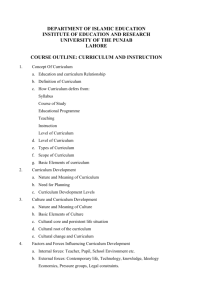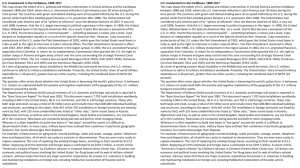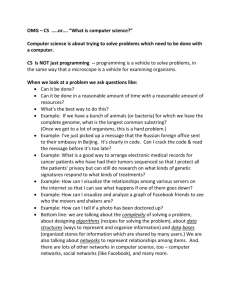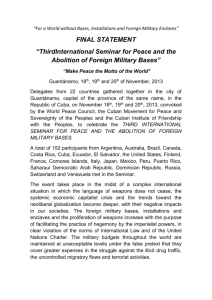Geography in the News™ THE UNITED STATES
advertisement
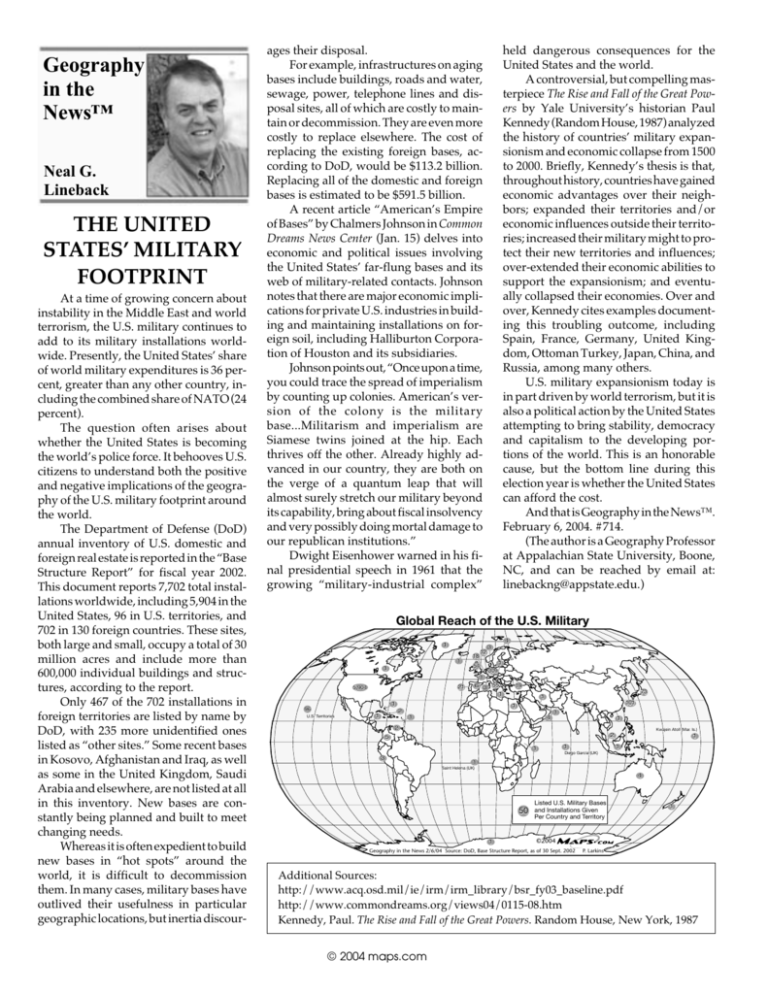
Geography in the News™ Neal G. Lineback THE UNITED STATES’ MILITARY FOOTPRINT At a time of growing concern about instability in the Middle East and world terrorism, the U.S. military continues to add to its military installations worldwide. Presently, the United States’ share of world military expenditures is 36 percent, greater than any other country, including the combined share of NATO (24 percent). The question often arises about whether the United States is becoming the world’s police force. It behooves U.S. citizens to understand both the positive and negative implications of the geography of the U.S. military footprint around the world. The Department of Defense (DoD) annual inventory of U.S. domestic and foreign real estate is reported in the “Base Structure Report” for fiscal year 2002. This document reports 7,702 total installations worldwide, including 5,904 in the United States, 96 in U.S. territories, and 702 in 130 foreign countries. These sites, both large and small, occupy a total of 30 million acres and include more than 600,000 individual buildings and structures, according to the report. Only 467 of the 702 installations in foreign territories are listed by name by DoD, with 235 more unidentified ones listed as “other sites.” Some recent bases in Kosovo, Afghanistan and Iraq, as well as some in the United Kingdom, Saudi Arabia and elsewhere, are not listed at all in this inventory. New bases are constantly being planned and built to meet changing needs. Whereas it is often expedient to build new bases in “hot spots” around the world, it is difficult to decommission them. In many cases, military bases have outlived their usefulness in particular geographic locations, but inertia discour- held dangerous consequences for the United States and the world. A controversial, but compelling masterpiece The Rise and Fall of the Great Powers by Yale University’s historian Paul Kennedy (Random House, 1987) analyzed the history of countries’ military expansionism and economic collapse from 1500 to 2000. Briefly, Kennedy’s thesis is that, throughout history, countries have gained economic advantages over their neighbors; expanded their territories and/or economic influences outside their territories; increased their military might to protect their new territories and influences; over-extended their economic abilities to support the expansionism; and eventually collapsed their economies. Over and over, Kennedy cites examples documenting this troubling outcome, including Spain, France, Germany, United Kingdom, Ottoman Turkey, Japan, China, and Russia, among many others. U.S. military expansionism today is in part driven by world terrorism, but it is also a political action by the United States attempting to bring stability, democracy and capitalism to the developing portions of the world. This is an honorable cause, but the bottom line during this election year is whether the United States can afford the cost. And that is Geography in the News™. February 6, 2004. #714. (The author is a Geography Professor at Appalachian State University, Boone, NC, and can be reached by email at: linebackng@appstate.edu.) ages their disposal. For example, infrastructures on aging bases include buildings, roads and water, sewage, power, telephone lines and disposal sites, all of which are costly to maintain or decommission. They are even more costly to replace elsewhere. The cost of replacing the existing foreign bases, according to DoD, would be $113.2 billion. Replacing all of the domestic and foreign bases is estimated to be $591.5 billion. A recent article “American’s Empire of Bases” by Chalmers Johnson in Common Dreams News Center (Jan. 15) delves into economic and political issues involving the United States’ far-flung bases and its web of military-related contacts. Johnson notes that there are major economic implications for private U.S. industries in building and maintaining installations on foreign soil, including Halliburton Corporation of Houston and its subsidiaries. Johnson points out, “Once upon a time, you could trace the spread of imperialism by counting up colonies. American’s version of the colony is the military base...Militarism and imperialism are Siamese twins joined at the hip. Each thrives off the other. Already highly advanced in our country, they are both on the verge of a quantum leap that will almost surely stretch our military beyond its capability, bring about fiscal insolvency and very possibly doing mortal damage to our republican institutions.” Dwight Eisenhower warned in his final presidential speech in 1961 that the growing “military-industrial complex” Global Reach of the U.S. Military 4 1 3 1 12 18 1 54 1 309 1 6 3 55 1 21 5,904 1 96 19 73 1 101 1 2 U.S. Territories 1 1 1 4 1 2 Kwajein Atoll (Mar. Is.) 2 5 1 1 1 1 Diego Garcia (UK) 3 1 Saint Helena (UK) 4 50 1 Listed U.S. Military Bases and Installations Given Per Country and Territory 1 ©2004 Geography in the News 2/6/04 Source: DoD, Base Structure Report, as of 30 Sept. 2002 P. Larkins Additional Sources: http://www.acq.osd.mil/ie/irm/irm_library/bsr_fy03_baseline.pdf http://www.commondreams.org/views04/0115-08.htm Kennedy, Paul. The Rise and Fall of the Great Powers. Random House, New York, 1987 © 2004 maps.com
